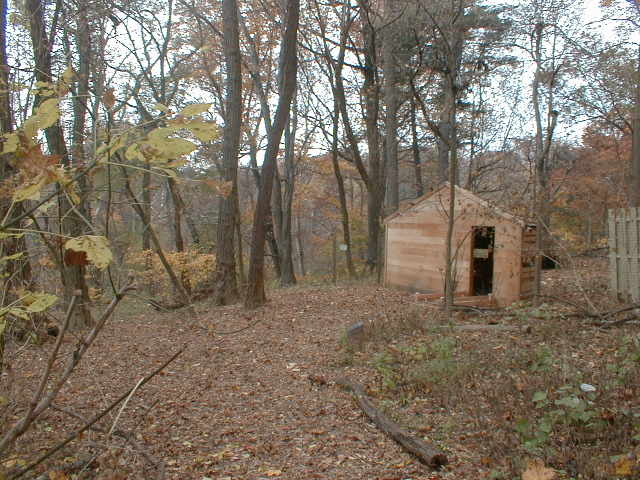 Walking in places where traces of the natural land remain, like Pennypack Park (in Northeast Philadelphia) or John Heinz Wildlife Refuge near the airport, reminds us that human constructs like cities are not our natural habitat. But the city is never that far from the urban schmoozer who, when finding the vestiges of human presence from the past–an old chimney left standing, an ancient log cabin, an arrowhead–experiences a delight, a sense of discovery.
Walking in places where traces of the natural land remain, like Pennypack Park (in Northeast Philadelphia) or John Heinz Wildlife Refuge near the airport, reminds us that human constructs like cities are not our natural habitat. But the city is never that far from the urban schmoozer who, when finding the vestiges of human presence from the past–an old chimney left standing, an ancient log cabin, an arrowhead–experiences a delight, a sense of discovery.
Ed Levine’s three pieces installed in Pennypack Park as part of the Fairmount Park Art Association‘s New-Land-Marks program to install art in public spaces give a little of that thrill of ancient civilization rediscovered.
The three pieces–“Birdblind,” “Benches,” and “Thoreau’s Hut”–“Embodying Thoreau: dwelling, sitting, watching”–clearly suffer from too many names, but the work itself is plain and Shaker-like. In fact, the birdblind is as unprepossessing as you can get from the human side–a flat little shed (see above), right near the offices of the park.
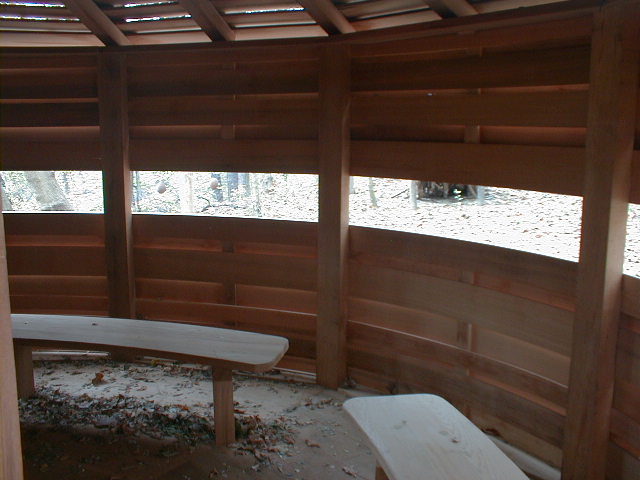 The birds have the better view from outside, because they can see the semi-circular wall. But go inside and the semicircular wall with its slot peering out affords a panoramic view of where the birds are supposed to be. The blind’s benches, also curved, are beautifully made.
The birds have the better view from outside, because they can see the semi-circular wall. But go inside and the semicircular wall with its slot peering out affords a panoramic view of where the birds are supposed to be. The blind’s benches, also curved, are beautifully made.
I had trouble thinking this was sculpture. It was, ultimately, just a beautifully made birdblind.
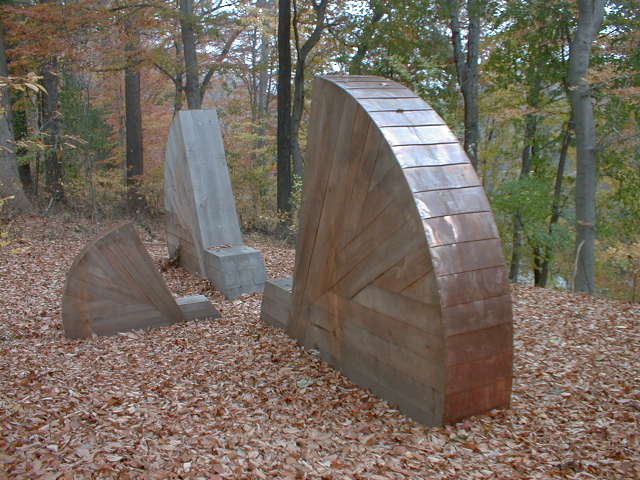 I got lucky following directions to get to the chairs and didn’t go down to the path closest to the river. That would have been a mistake. The chairs are about a half mile along the middle path. Three paths, three chairs–the poppa chair, the momma chair, and the little itty bitty baby chair. Like Goldilocks, I sat on all three and tested the view. Very nice. These, like the birdblind, scored high on the function meter.
I got lucky following directions to get to the chairs and didn’t go down to the path closest to the river. That would have been a mistake. The chairs are about a half mile along the middle path. Three paths, three chairs–the poppa chair, the momma chair, and the little itty bitty baby chair. Like Goldilocks, I sat on all three and tested the view. Very nice. These, like the birdblind, scored high on the function meter.
There’s a brutish, clunky quality about these hemispheres with chunks bitten out. I liked the copper rind along the curved edge. I liked the suggestion of cross-sections of giant trees. So these succeeded at taking me beyond chairness and reminding me of my human scale against the majesty of nature, but if couldn’t quite stop questioning their awkward appearance. Which is not to say I wasn’t overjoyed in discovering them or sitting in them or thinking about their shape and scale.
Like the other two pieces, they blend in, just the right degree of obtrusiveness and unobtrusiveness in the woody setting.
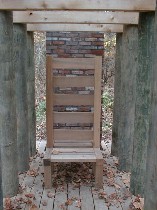 Another half a mile along the same path, Thoreau’s Hut pops into view. It too was just visible enough to be spotted in the woods. In the form of a shelter that gives virtually no shelter–the roof and sides are open–it provides an austere, two-sided chair for contemplation of nature (contemplating nature is the theme in all of these pieces).
Another half a mile along the same path, Thoreau’s Hut pops into view. It too was just visible enough to be spotted in the woods. In the form of a shelter that gives virtually no shelter–the roof and sides are open–it provides an austere, two-sided chair for contemplation of nature (contemplating nature is the theme in all of these pieces).
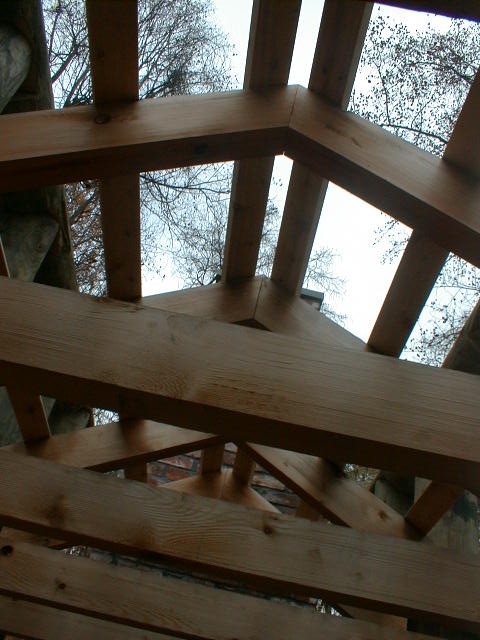
I found this the most poetic of all. The view of the sky and the woods, the platform/floor, the treetrunk frame, the back-to-back seating clearly are not artifacts from the past, but they hark to it and improve on it. The house is a little world both in and out of and part of nature.
All three score high on the public art need to create a sense of place. If we’re hiking on the same day, I can say, Meet me at the birdblind; or Meet me at the three chairs or Thoreau’s Hut. They feel friendly and usable and they respond to the environment around them. I imagine people who use the park will enjoy using the pieces.
My initial response was that they succeeded as architecture and are an asset to the park. To call them sculpture (especially the birdblind) seems a stretch.









